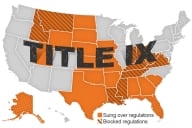You have /5 articles left.
Sign up for a free account or log in.
West Virginia is moving towards to providing a “last dollar” benefit to make community college free for its residents, with a bipartisan bill moving through the state Senate and on to the House of Delegates.
There’s one catch. To qualify, prospective students must take and pass a drug test, paid for out of their own pockets.
Irritated, I fired off a tweet attached to the story:
Then I began to wonder if I was right.
West Virginia is one of the states most affected by the crisis of opiate addiction with individuals overdosing at the highest rate in the country in 2016. This is probably related to things such as more than 20 million prescription painkillers (hydrocodne and oxycodone) being sent to two pharmacies in single town of 3000 people.
It’s hard to know what percentage of prospective West Virginia community college students might not pass a drug test, though if it’s opiates we’re concerned about, it’s worth acknowledging that those 20 million plus pills were dispensed “legally.”
But thanks to the annual Harvard Senior Survey we have a fairly reliable gauge of what’s happening drug-wise at our most elite institution.
- Just over half of Harvard seniors used marijuana at least three times a semester. Nine percent used more than once a week or daily.
- Nineteen percent used “hard drugs” (LSD, cocaine, etc...) at least three times per semester. Seven percent used at least 1-3 times per month. That 19% reflects more than 300 total students from the senior class alone.
One has to believe the percentages hold at least relatively true for the rest of the student body. Taken as a whole, depending on when and what drug was used, at any given time during the school year, more than half of Harvard’s student body would test positive for illicit drugs.
Of course, no one is worried if Harvard students are doing drugs or drinking their brains out.[1] They’re at Harvard and therefore are largely insulated from the sorts of accountability routinely required of the less powerful.
If the proposed drug testing was meant to identify those in need of treatment and rehab perhaps I could be supportive of the initiative, except this is not the case. The Trump Administration task force has done little to nothing to address what it called a “public health emergency,” prompting one member of the task force to call the entire exercise “a charade.”
The policy also gets incentives for recovery backwards. As Nathan Sorber, a professor of higher-education administration at West Virginia tells the Chronicle of Higher Education, “Getting into college itself can be a part of the road to recovery.”
The most bothersome part of the plan is the incredible waste of time and money which could be better used elsewhere. Previous programs to screen and test for drugs among public assistance recipients have cost millions with little to show for the time and expense spent.
In a study covering seven states which screen and test recipients of government benefits for drugs, those in assistance programs tested positive at a lower rate than the general population.
For example, from 2010-2014 Arizona, processed over 140,000 applicants for assistance, resulting in three positive tests.
For the poor, there are always hoops to jump through, while the rich find loopholes.[2]
Consider the parade of grifters currently moving through our federal government. Just from the last week:
- CDC Director Brenda Fitzgerald was forced to resign after it was revealed she purchased tobacco stocks after taking her post.
- A lobbyist for the corn syrup industry is now inside the Trump Administration, helping set USDA dietary guidelines.
- And of course taxpayer funds continue to flow into a variety of Trump businesses.
The overwhelming evidence shows that the best way to aid the poor is direct cash transfers. It turns out if you give people who don’t have enough money additional funds, they’ll use it to address their most urgent needs. But in this country, we do not trust the poor. The attitude seems to be if they were trustworthy, they wouldn’t be poor.
One would think conservatives could appreciate the efficiency of a direct cash transfer given that following the successful passage of the tax bill, House Speaker Paul Ryan received a $500,000 donation from the Koch family.[3]
The West Virginia free community college program would cost $8 million, a significant sum for a struggling state, which has cut $15 million out of the community college system over the last five years.
But maybe we should look at another way: It’s only 16 Koch family donations to Paul Ryan worth.
[1] They’re doing this too. According to the same senior survey, 39% drink at least twice a week. Students whose annual household incomes were at least $250,000 were twice as likely to drink at least once a week versus those with household incomes below $40,000.
[2] Wisconsin is now heading toward a system where even those on food stamps must be tested for drugs.
[3] The Kochs plan to spend $400 million on the 2018 election cycle. This is all completely legal, of course, because millions of dollars were poured into the campaign to overturn campaign finance legislation with the Citizens United case.





